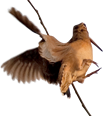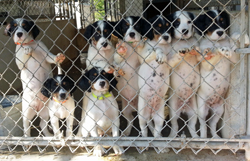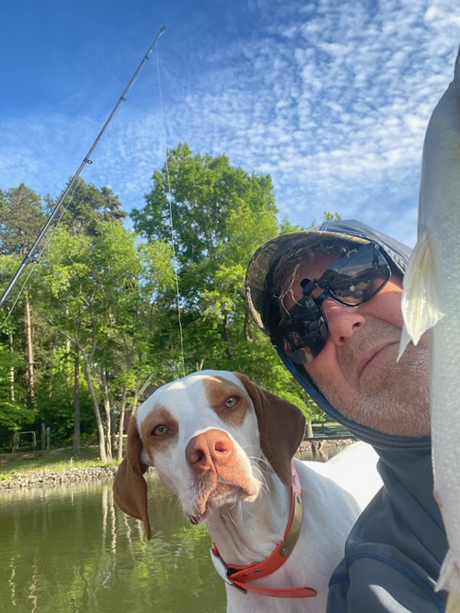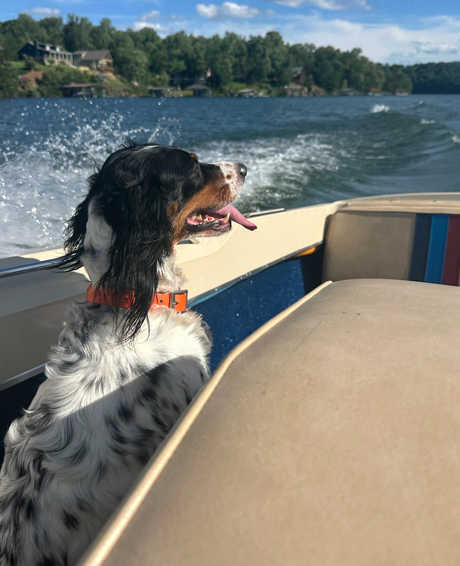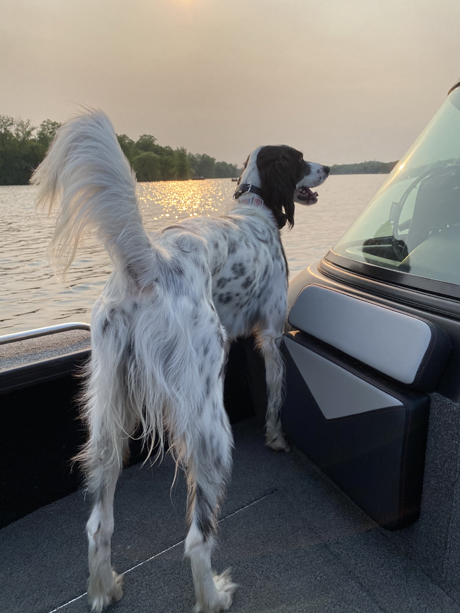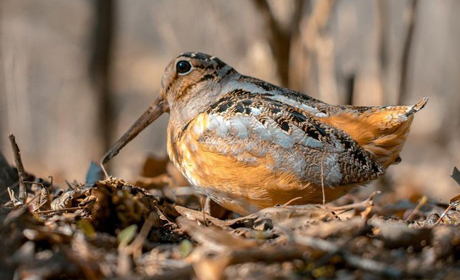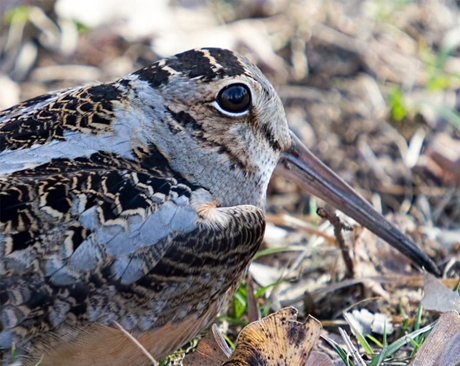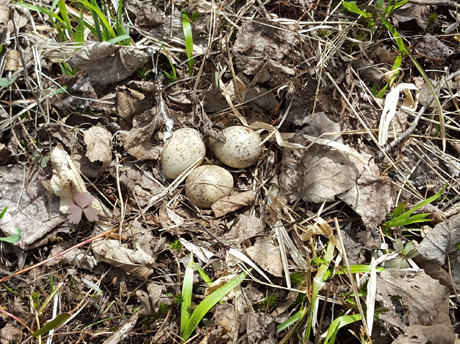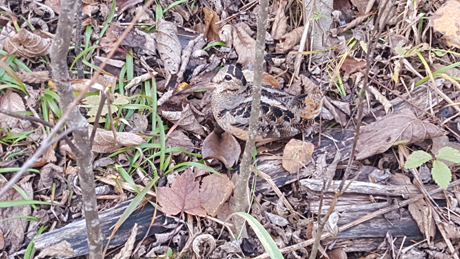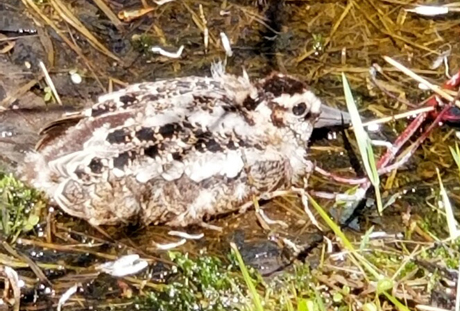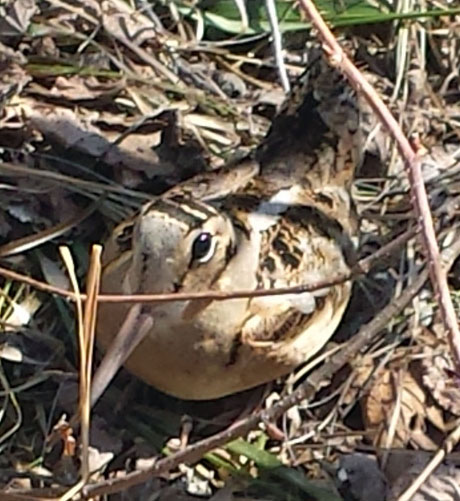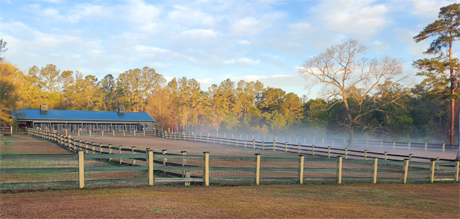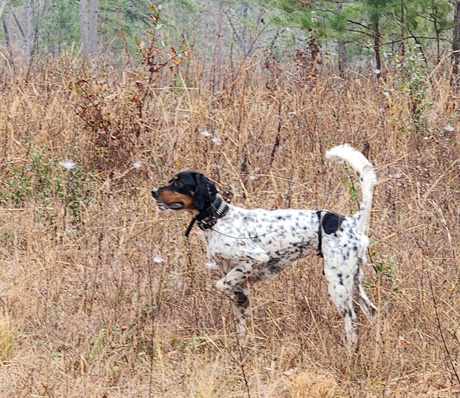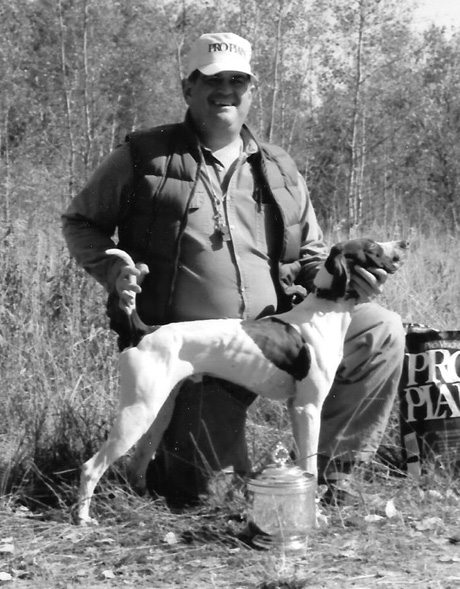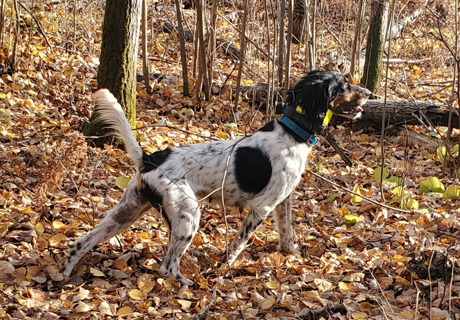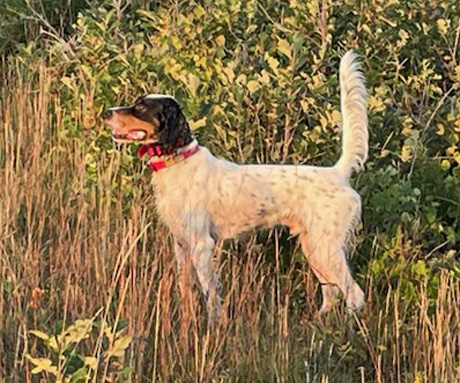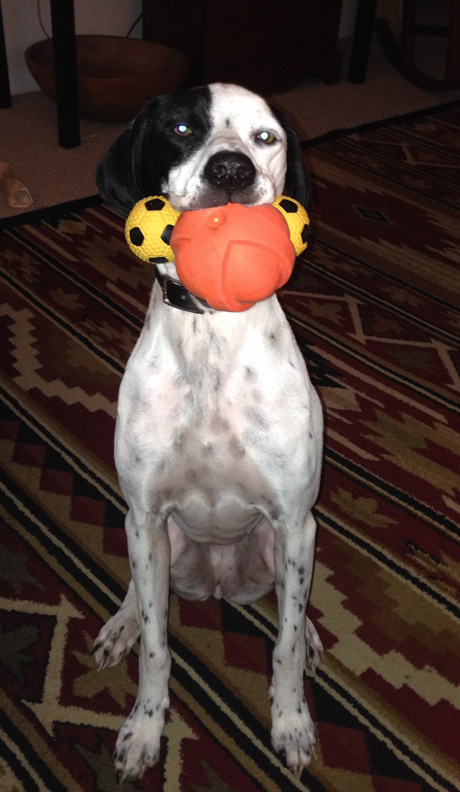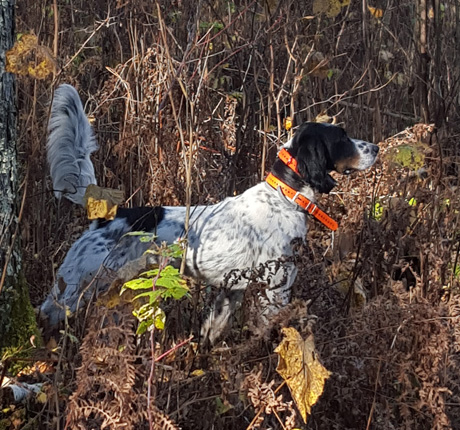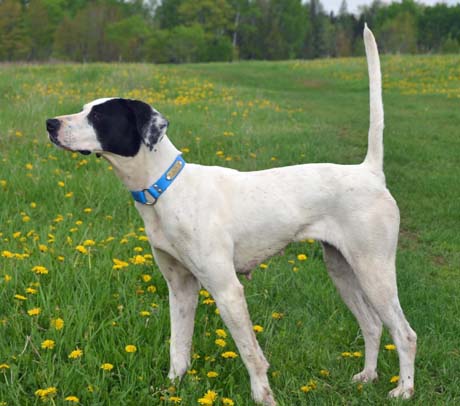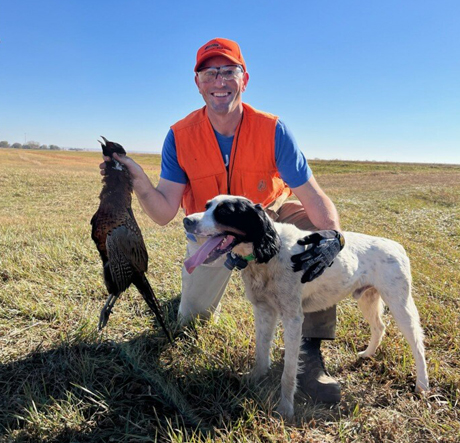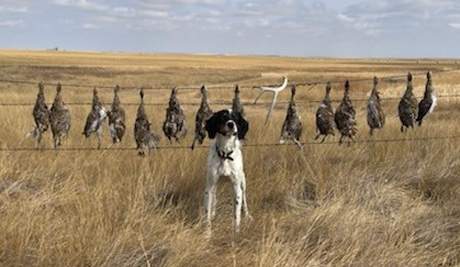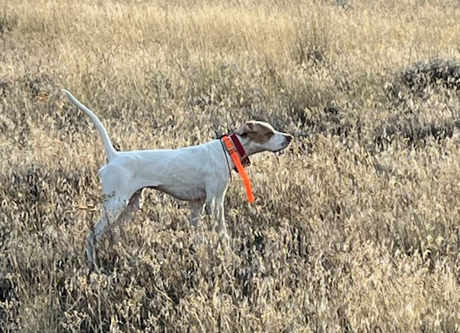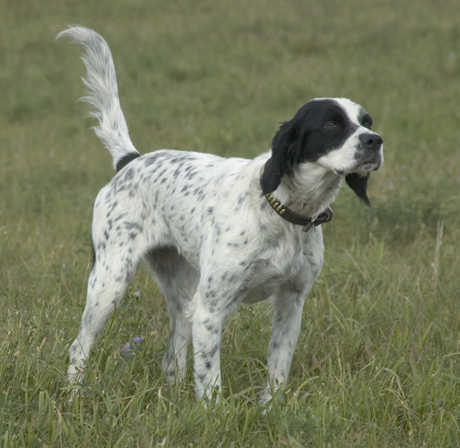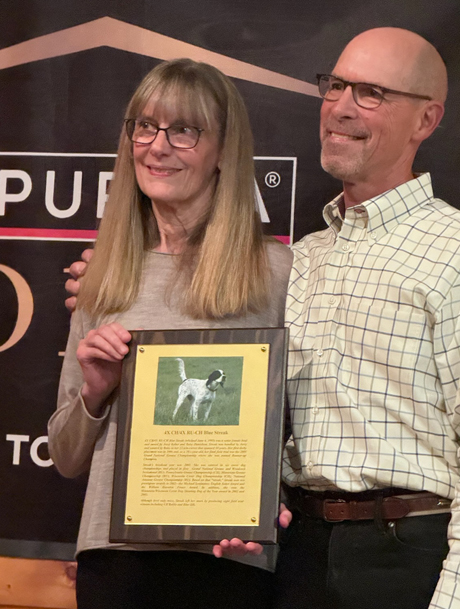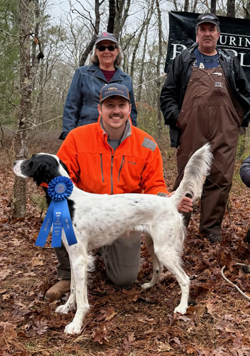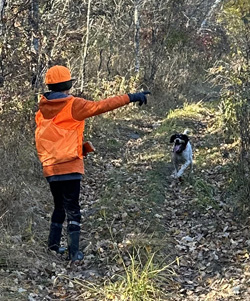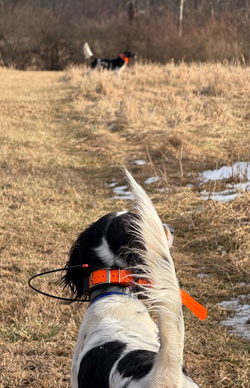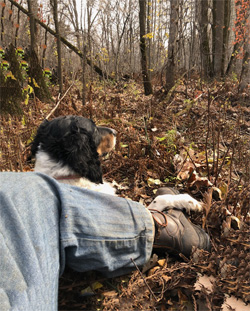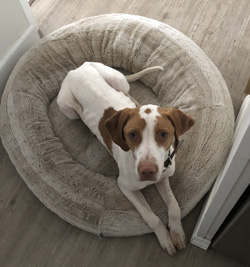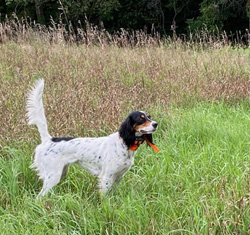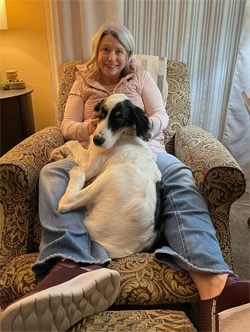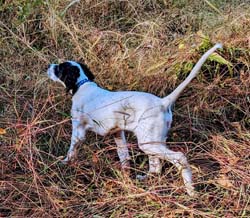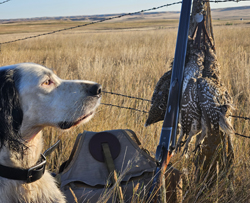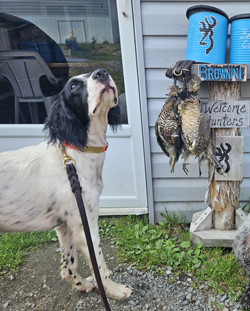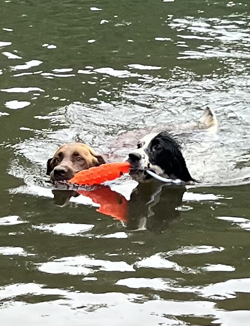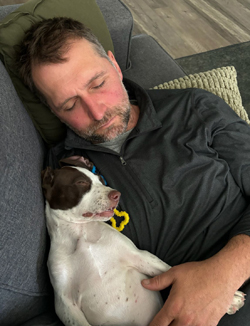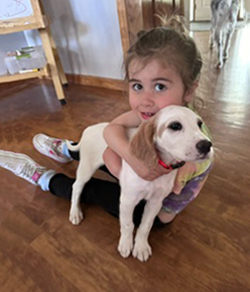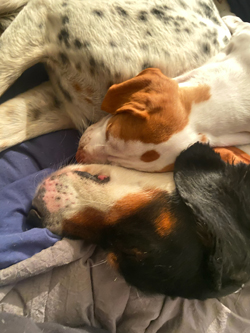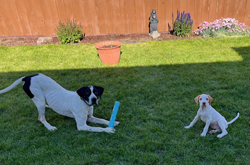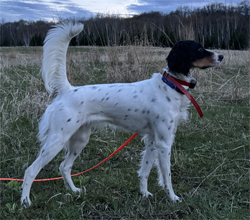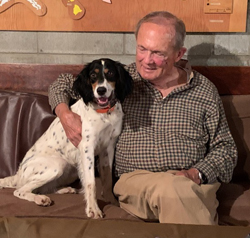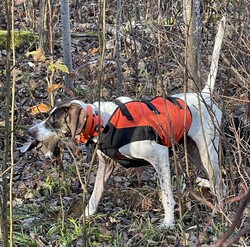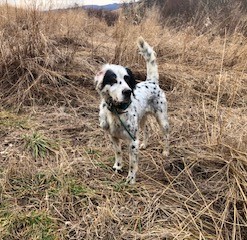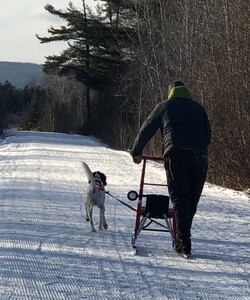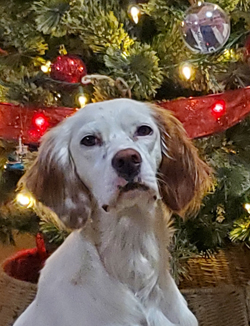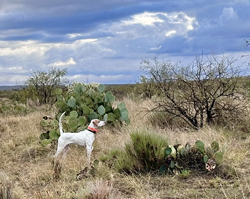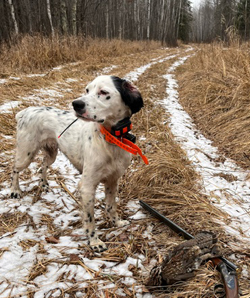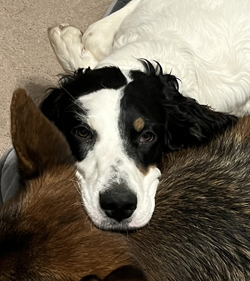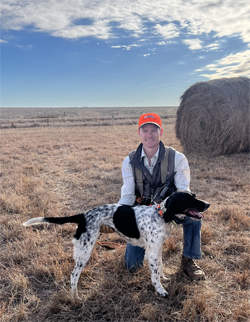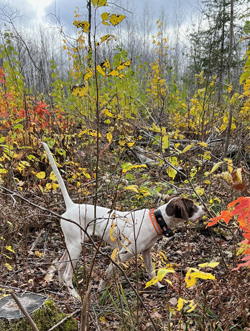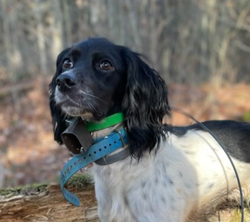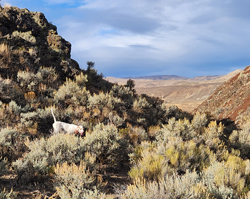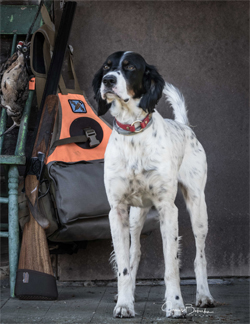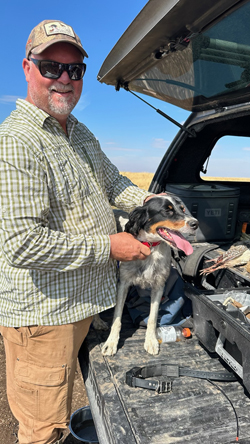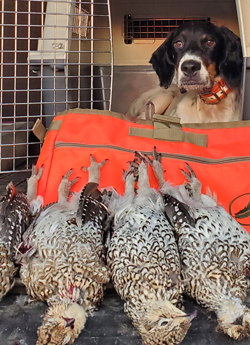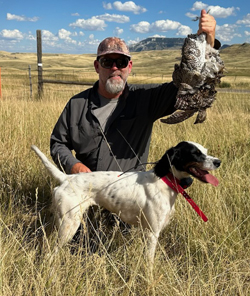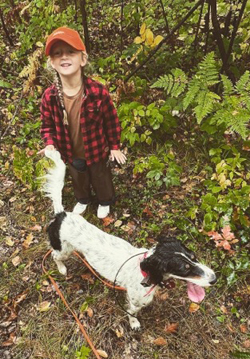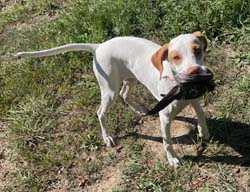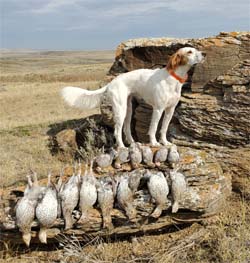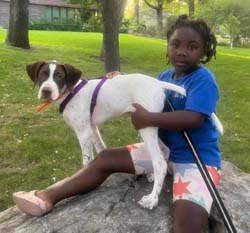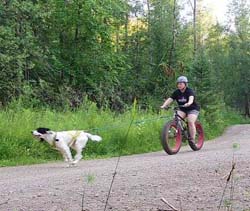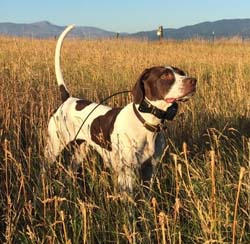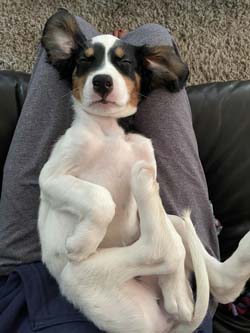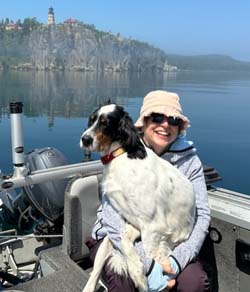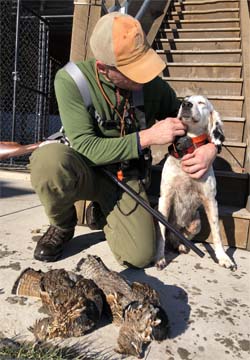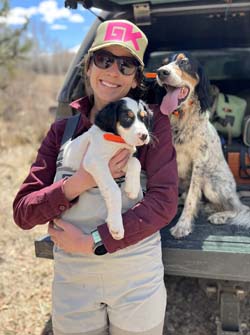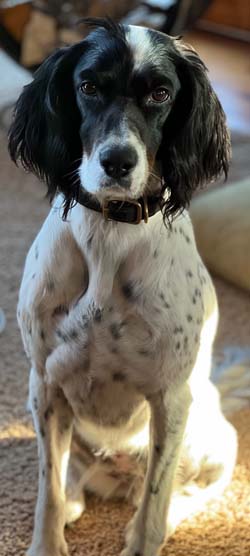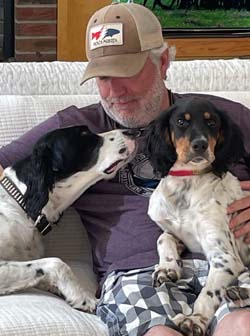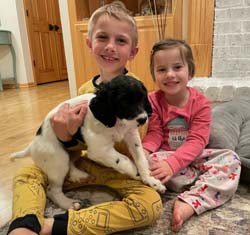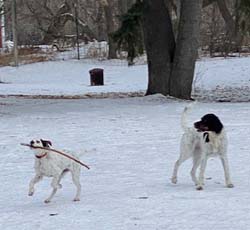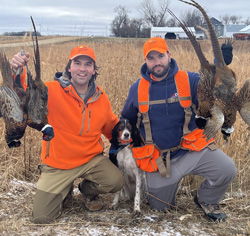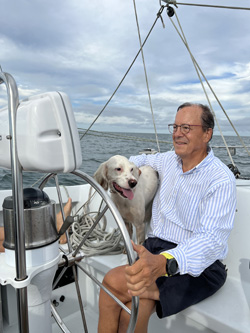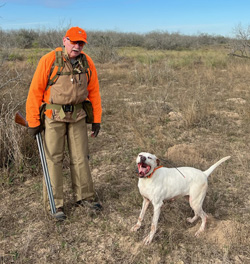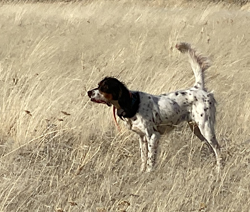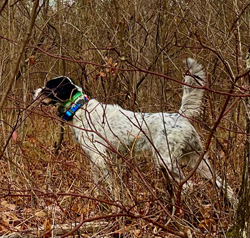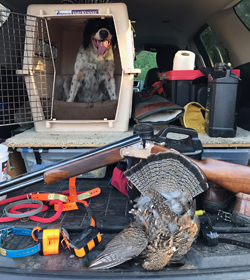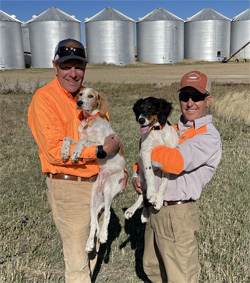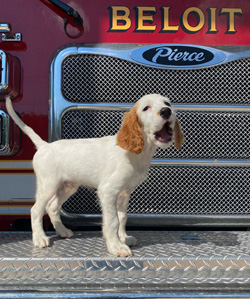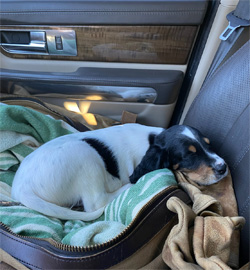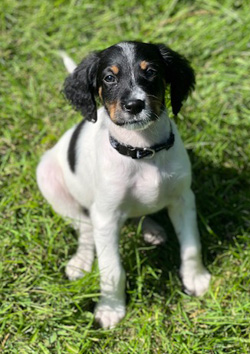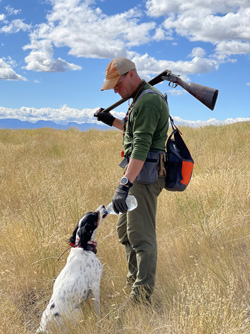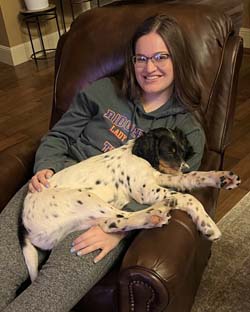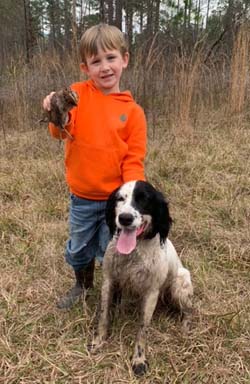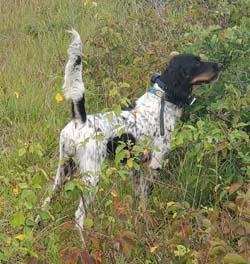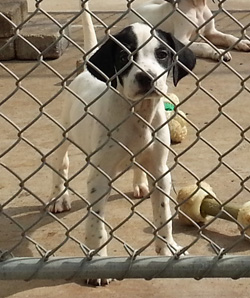Bird dogs in boats
What’s a bird dog to do when the hunting season has long passed and any spring work is also over?

Caddie (CH Southern Confidence x Northwoods Comet, 2023), on left, and Lacey (CH Elhew G Force x Northwoods Vixen, 2016)
~ Brian Smith, Pennsylvania
Whether setter or pointer, some lucky Northwoods dogs are invited onto their owners’ boats. Two pointer females from Pennsylvania assisted their owner on a fishing trip. One setter watched her champion skier practice on a Georgia lake.
In the Atlantic Ocean off Nantucket, two setter females, experienced on sailboats and Zodiacs, rode in the bow. One setter simply enjoyed an afternoon cruise on a lake in Minnesota.
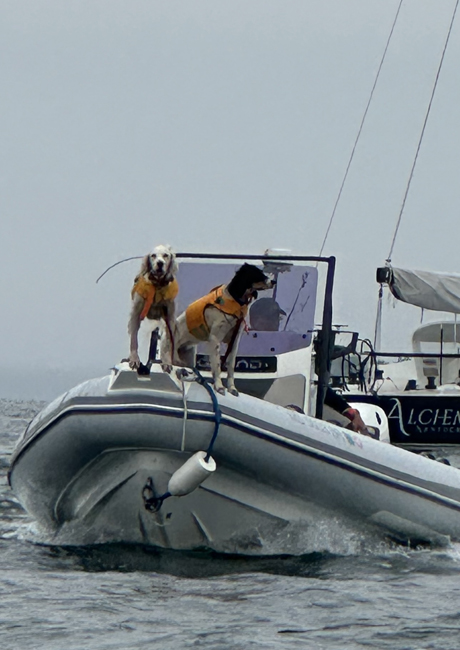
Lacey (Northwoods Grits x Northwoods Minerva, 2020), on left, and Maisy ( RU-CH Northwoods Atlas x Houston’s Nelly Bly, 2023)
~ Zenas and Susanne Hutcheson, Massachusetts
Northwoods Cedar named Runner-Up Champion at the 2025 Invitational
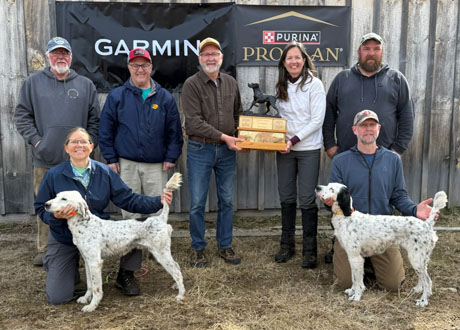
CH/2X RU-CH Northwoods Cedar (RU-CH Erin’s Prometheus x Northwoods Carly Simon, 2019), on right, poses with handler Eric Saetre at the 2025 Grand National Grouse and Woodcock Invitational. Cedar was named Runner Up Champion. Lindsey Saetre helps hold the impressive trophy.
CH/2X RU-CH Northwoods Cedar (RU-CH Erin’s Prometheus x Northwoods Carly Simon, 2019) was named Runner-Up Champion at this spring’s Grand National Grouse and Woodcock Invitational Championship. Cedar is owned by Eric and Lindsey Saetre of Minnesota.
The trial is conducted annually by the Grand National Grouse Championship and is held at various venues around the country. The New England Bird Dog Club hosted this year’s—the 34th—at the Panther Forest Wildlife Reserve near Ellenburg, N.Y.
This prestigious trial is limited to 14 entries making it the smallest championship on the circuit. Yet, it’s arguably the hardest one to win.
First of all, you can’t just enter a dog. The dog has to be invited. Invitations are extended to the top 11 point-earners based on placements in the prior cover dog trial season. Rounding out the 14 dogs are automatic invitations to the previous year’s champion and runner-up and to the Grand National Grouse Championship winner.
Besides the invitation part, the dog has to run in one-hour braces on two consecutive days.
The first day of running, as in any trial, is randomly drawn. But for the second day, the dogs are paired with a different bracemate on a different course and run at a different time of day, i.e., dogs that ran in the morning the first day run in the afternoon on the second day.
After the second day, tension, nerves and excitement are high for handlers, scouts and owners. They’ve all had a fair shot to show their dog. They can’t complain about any of the normal variables in a field trial draw—time of day, course, bracemate, weather. The Invitational format is designed to reduce some of those variables, or, as stated in its Invitational’s Bylaws and Running Rules: “to take as much luck out of the trial as humanly possible.”
The third day’s running includes only the “call-backs” as determined by the two judges. They decide which dogs they want to see, how to pair them and on which course. Again, the braces are one hour long.
All three days of running are considered in the final decision.
With the exception of the third day, the weather this year was problematic. Deep snow restricted range and clogged bells made for difficulty tracking dogs. Cold temperatures were hard on everyone. Those conditions affected the birds, too.
In spite of the weather, Cedar ran consistently and was the only dog to point birds all three days. Her performance and bird-finding earned her placement as Runner-up Champion.
Eric as handler and Lindsey as scout have done an outstanding job with Cedar. Their hard work and dedication fine-tuned Cedar’s genetic ability into a national caliber competitor. Betsy and I are proud of them and wish them the best in the fall trial season and next year when they’re invited back to the 2026 Invitational.
Two other local dogs were invited to this renewal. 2X RU-CH Northwoods Atlas (Northwoods Grits x Northwoods Nickel, 2017), owned by Greg and Michelle Johnson of Wisconsin, was posthumously invited. Lake Affect Allie, owned and handled by Tim Kaufman of Wisconsin, was invited and competed in the trial.
American Woodock (Scolopax minor)
On a cold, cloudy day in late March, Jerry and I took our one-year-old female setter Dilly (CH Woodville’s Yukon Cornelius x Northwoods Redbreast, 2024) to a nice woodcock spot of young aspen and sparse undergrowth.
Dilly was exuberant—whether due to her age or the conditions or both—but we knew she was hunting. We were all rewarded when, within about 20 minutes, we found Dilly on point.
The woodcock were back!
For many upland hunters and dog owners, the return of the woodcock is an important part of the natural rhythm of things. It confirms the seasonal shift from winter to spring.
And how can one not be excited about that return? How can one not be enchanted by woodcock and delight in their oddities? There aren’t many birds that have a cuter, rounder body or a longer beak. Breast meat is dark and leg meat is white. A woodcock’s brain is, basically, upside down. Ears are placed under its eyes, which are situated far back on its head.
And those eyes! In “Making Game: An Essay on Woodcock,” Guy De La Valdene writes that a woodcock’s eyes are “black and limpid, not eyes to dwell on if one intends to keep hunting.”
Taxonomy
The scientific name of the American woodcock is Scolopax minor. It is the only upland bird in the large Scolopacidae family, a major shorebird family. Other members include sandpipers, curlews, godwits, dowitchers and snipe.
Besides the American woodcock, there are seven other members of the Scolopax genus. Eurasion woodcock, S. rusticola, is native across Europe and Asia from Ireland to Japan. There are six other species, each native to their own small island.
All family members are ground nesters and usually the nest is just a scrape. It might not seem like ample protection but the camouflage is ideal. Generally, 2-4 eggs are laid and are colored and spotted to blend in. At birth, precocial young are covered with down and, with the help of a parent, are mobile enough to leave the nest within hours.
Evolution
Birds date to the Cretaceous period (135 – 66 million years ago) of the Mesozoic era, a.k.a., the age of dinosaurs. Birds with beaks survived the asteroid-induced mass extinction at the end of that period most likely because they could eat plants.
The first woodcock fossil discovery was from about 20 million years ago. When the glaciers began retreating during the later Pleistocene epoch of the Cenozoic era (about 20,000 – 30,000 years ago), woodcock followed. They ended up in their current locales at the end of that retreat.
Range and Habitat
The woodcock population in the U.S. is divided into two major groups: Eastern (from the Appalachian Mountains to the east) and Central (west of the Appalachians to western edge of the Minnesota/Iowa/Missouri borders). The Eastern birds generally migrate along the Atlantic coast and the Central population usually follows the Mississippi River.
Woodcock like successional deciduous forests where there is rich soil. In addition, they need open areas–fields, grasslands or forest cleanings–and shrubby areas.
Woodcock roost, forage and practice their mating ritual—the sky dance—in open areas. They move to the cover of a forest during the day to forage and to avoid predation.
Avoiding predation
A woodcock’s prime methods of predator evasion are not moving and camouflage. Countless times while training young dogs, Jerry and I would stop to listen for the bell of the errant dog. Within about a minute and usually no more than 15 feet away, a woodcock flushed, thinking we had moved on.
A woodcock’s approximately 1,000 feathers are flawlessly arranged in various patterns that perfectly mimic the accumulated detritus of the forest floor. The colors of those feathers, as described in De La Valdene’s book, include “cream, cinnamon, ochre, black, burnt umber, raw sienna, brown and auburn” and five shades of gray.
Fun facts about food, nesting and migration
• Males and females have similar feather arrangement and colors. Females, called hens, are a little larger and have slightly longer wings and bills.
• Woodcock are solitary birds and except when breeding or rearing chicks spend their days alone.
• Woodcock eat worms…lots of worms. Estimates vary but somewhere between 60-90% of their diet is worms, which are high in protein, fat and water. Other foods include insects, grubs and larvae.
• When walking through the woods, woodcock bob and rock back and forth and look, somewhat, like they’re dancing the two-step. One theory is they are causing vibrations in the soil which can cause worms to come to the surface.
• In addition to peents and chirps of the sky dance, males cackle to warn off other males. A whistle noise is made by their fast-beating wings, such as when they flush.
• Snow and heavy rains during nesting can be detrimental.
• When woodcock eggs hatch, the eggs are split lengthwise.
• Hens will use the “broken wing” trick to lure predators away from their nests.
• Woodcock take it easy when they migrate. In general, they’re not rushing either north or south and often are the last bird to migrate in the fall.
• Snowstorms, thunderstorms and strong winds impact migration. Woodcock will simply wait for the weather to improve before continuing.
Saving the best for last: The Sky Dance
Most male members of the Scolopacidae family have some sort of aerial display for breeding. Woodcock are renowned for their ritual, nicknamed the “sky dance.” I’ve heard it many times and in many spring seasons around our house and kennel.
Aldo Leopold exquisitely describes it in “A Sound County Almanac.”
“He flies in low from some neighboring thicket, alights on the bare moss, and at once begins the overture: a series of queer throating ‘peents’ spaced about two seconds apart, and sounding much like the summer call of the nighthawk.
“Suddenly, the peenting ceases and the bird flutters skyward in a series of wide spirals, emitting a musical twitter. Up and up he goes, the spirals steeper and smaller, the twittering louder and louder, until the performer is only a speck in the sky. Then, without warning, he tumbles like a crippled plane, giving voice in a soft liquid warble that a March bluebird might envy. At a few feet from the ground he levels off and returns to his peenting ground, usually to the exact spot where the performance began, and there resumes his peenting.”
Living in southwestern Georgia in winter
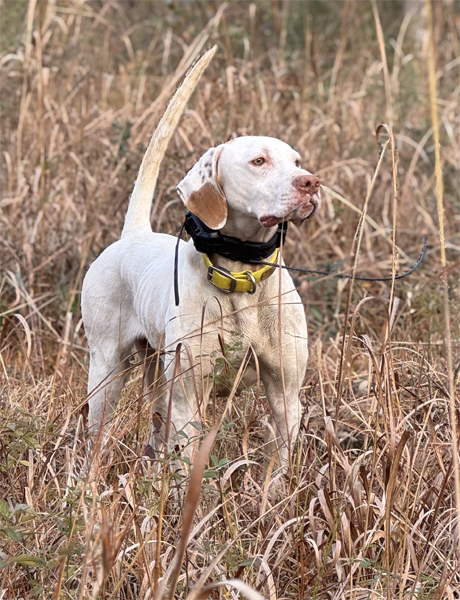
On a find in the middle of a block, Northwoods Confidante (HOF CH True Confidence x Red Sunshine, 2022), call name Sophie, oozes confidence and style. Photo by Ben McKean.
Jerry and I have reached the age when many of our siblings, friends and clients are retired. Some head off to winter places in Florida, California and other warmer regions with a couple pieces of luggage and few responsibilities.
Not so for us.
While we do head south, we haven’t retired. Our destination isn’t sandy beaches or country clubs. Instead, our vehicles and a horse trailer are stuffed with dogs, training equipment, horse tack, office supplies and all sorts of boots, jackets and hats. We spend the winter training dogs and otherwise taking care of our business.
A decade ago, Jerry and I discovered a small corner of southwestern Georgia. It has a perfect climate, park-like woods to train our dogs and Thomasville, a nearby, charming small town complete with a brick main street, bird dog/hunting vibe and wonderful restaurant and shopping choices. There’s even a health club with a 6-lane, 30-meter, outdoor swimming pool.
But what primarily drew us to this region were wild birds. Beginning in the late 1800s, dozens of vast plantations were established which were devoted exclusively to wild bobwhite quail. Even though ownership and boundaries of many plantations have changed, quail management and hunting traditions remain strong.
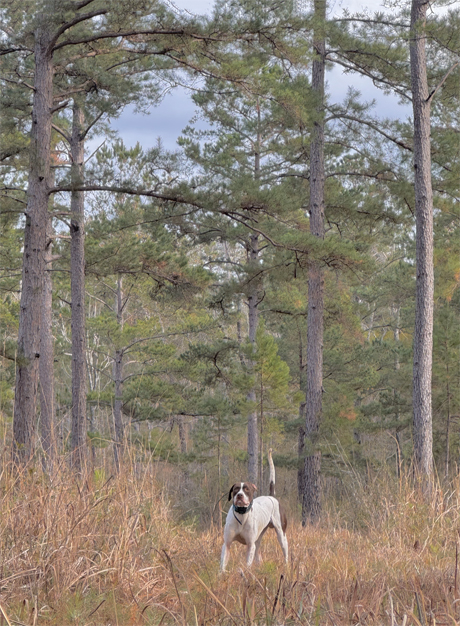
Two-year pointer male Northwoods Rudolph (CH Southern Confidence x Northwoods Comet, 2023, call name Rudy, points on a chopper trail amidst statuesque loblolly pines. Photo by Ben McKean.
Other reasons keep us going back. The majestic overstory of the woods are native longleaf and loblolly pines. The undergrowth, perfect quail habitat, is managed through periodic fires. Buildings—whether houses, horse barns or dog kennels—are landscaped with massive live oaks, dogwoods, redbuds, magnolias, azaleas and camellias.
These trees and shrubs are home to a large, noisy collection of songbirds. A favorite is the native, tiny brown-headed nuthatch that walks up, down and around the pine trunks and branches.
All these inducements aside, though, the bobwhite quail are the true magnets. From the first, we fell for their cute size, their calls, incredible camouflaged feathering and covey habits. Most thrilling is the sound of a covey rise when 10-20 birds flush.
Please enjoy the video below of our favorite sound in southwestern Georgia. It was edited during our 2020 winter. Also below are more photographs.
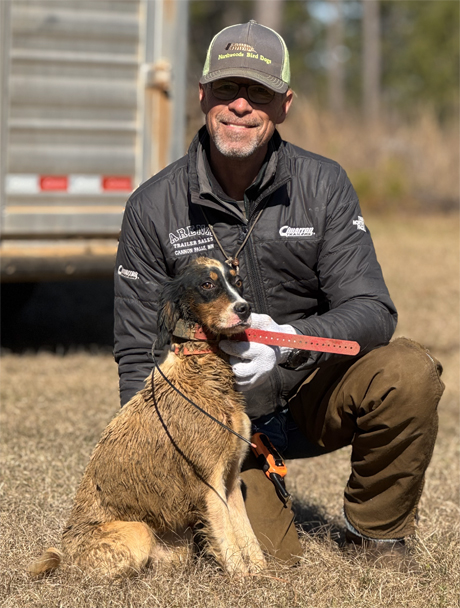
The woods were dry this winter but muddy ponds and puddles were still handy. Layla (RU-CH Northwoods Atlas x Houston’s Nelly Bly, 2023) is normally a beautiful tricolor female with a white body. Photo by Ben McKean.

A tunnel of live oaks, draped with native Spanish moss, leads toward a horse barn. Photo by Ben McKean.

The tradition of training bird dogs and hunting quail off horseback dates to the origin of quail plantations. Blaze, a 16-hands-high Tennessee walking horse, greets us at the corner of his paddock.
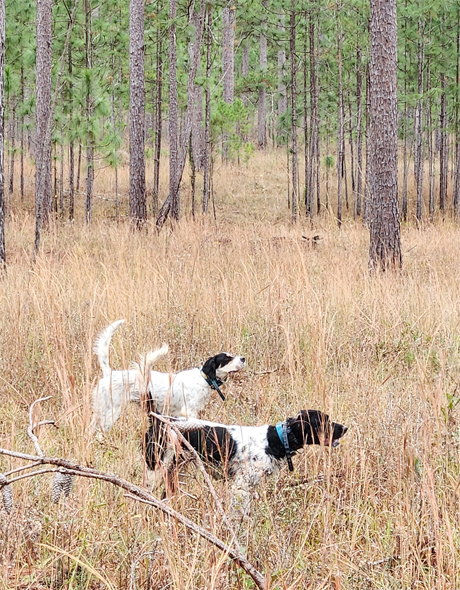
Jerry usually trains a brace of dogs and often pairs a young dog with an experienced one. Northwoods Stardust (RU-CH Erin’s Prometheus x Northwoods Carly Simon, 2019), call name Dusty, and Northwoods Snowswept (CH/RU-CH Northwoods Sir Gordon x Northwoods Valencia, 2023), call name Sweep, share point.
What if I’d said “WHOA”?
The video shows two young setters working wild bobwhite quail in southwestern Georgia. The dog in front that stopped looks, at first, relatively sure. But then he starts to move. He and the backing dog then both move up, point and move again.
Both dogs are trying to locate the birds. They eventually leave the area when they realize the birds are gone.
I never said a word. My only help was a soft whistle, encouraging them to move up.
This is the way to develop a wild bird dog. The handler should let the dog learn accurate location of the bird with minimal interference and, ultimately, learn how close it can get to the birds without causing the birds to flush. (The dog will flush some birds, but who cares? Give the dog freedom to make mistakes.)
What if I’d said “WHOA?” when I walked in on the point and the back? What if I had made the dogs stay on point when they first stopped? What if I’d corrected them?
The dogs would have learned that moving in the presence of bird scent is not allowed. Even if they wanted to move, staying put was the safest thing to do. The dogs would have learned to be more concerned about making a mistake than in handling the birds correctly.
And the dogs would have learned to depend on the handler to decide if the birds were there.
Be an advocate for your dog

Northwoods Rudolph (CH Southern Confidence x Northwoods Comet, 2023), a.k.a., Rudy, a.k.a., Goober, is recovering from serious abdominal surgery.
Be an advocate for your dog.
Jerry and I needed this advice recently as we struggled with a serious injury with Rudy, our big, handsome, two-year-old pointer male.
Not all veterinarians are created equal. As in any other profession, they range from outstanding to poor—whether considering knowledge, experience, competence, concern or care–and also considering equipment, staff and other resources.
We weren’t satisfied with Rudy’s care at the vet clinic that initially did the surgery and aftercare. On his behalf, we decided we needed to do something last week. We removed him from that clinic and then drove him—in his very ill, weakened state—to another clinic.
It was a bold move for us—and one that wasn’t entirely comfortable. But since we were convinced that Rudy was quickly digressing and could have died at the first clinic, the decision was straightforward.
We’re happy to report that Rudy had a second surgery and expert care at the new clinic. He is now home and on the path to a full recovery.
Be an advocate for your dog. It could save a life.
Fall 2024 field trial results

Big smiles are easy for a dog’s first championship. Northwoods Cedar (RU-CH Erin’s Prometheus x Northwoods Carly Simon, 2018) is the newly crowned champion at the North Country Shooting Dog Championship, held near Eau Claire, Wis. Proud owners are Eric and Lindsey Saetre. Cedar is handled by Eric and scouted by Lindsey.
Dogs out of our Northwoods breeding were big winners in field trials during the fall 2024 season. This included setters at all major field trials held in the Minnesota/Wisconsin area and a young setter in Pennsylvania.
Other winners include pointer littermates out of a Northwoods-bred sire.

At the Minnesota Grouse Championship, held near Mora, Minn., runner-up Northwoods Cedar, on right, is posed by owner and handler Eric Saetre while champion Over The Hill Morgan is posed by breeder and handler Rod Lein.
Northwoods Cedar (RU-CH Erin’s Prometheus x Northwoods Carly Simon, 2018), owned and handled by Eric and Lindsey Saetre, went on a roll this fall. She was named champion at the North Country Shooting Dog Championship and runner-up champion in the Minnesota Grouse Dog Championship. The wins put Cedar high on the list to run in the Grand National Grouse and Woodcock Invitational next spring.
Special congratulation to Eric and Lindsey for their work and dedication. Cedar is their first bird dog!. They bought her from us as a puppy six years ago.

Northwoods Rip Roy (CH Woodville’s Yukon Cornelius x Northwoods Redbreast, 2024) wins the blue ribbon at the NBHA Sharptail Championship Open Puppy stake held near Minong, Wis. Rip is owned and handled by Greg Johnson.
Northwoods Rip Roy (CH Woodville’s Yukon Cornelius x Northwoods Redbreast, 2024), owned and handled by Greg Johnson, had quite a fall for an eight-month-old-puppy. He placed in the following stakes:
• 1st NBHA Sharptail Championship Open Puppy
• 2nd Wisconsin Cover Dog Championship Open Derby
• 3rd North Country Shooting Dog Championship Open Derby
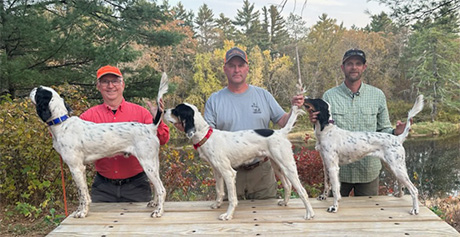
Clover Valley Mulak, handled by Greg Johnson and owned by Jerry Furnish, placed first in the Wisconsin Cover Dog Championship Open Derby held near Eau Claire, Wis. His littermate, Clover Valley’s Evans, handled by Jordan Pharris and owned by Jerry Furnish, placed third. Northwoods Rip Roy, owned and handled by Greg Johnson, rounded out the placements with a second place finish.
Three littermates out of RU-CH Northwoods Atlas (Northwoods Grits x Northwoods Nickel, 2017) x Clover Valley’s Millie had a banner season. They basically competed against each other and won nine placements in derby stakes. Jerry Furnish bred this outstanding litter out of his Millie, a granddaughter of another dog produced by us, CH Ridge Creek Cody.
Clover Valley’s Mulak, handled by Greg Johnson, owned by Jerry Furnish, had four placements.
• 1st Wisconsin Cover Dog Championship Open Derby
• 2nd Reuel Henry Pietz Derby Classic
• 2nd North Country Shooting Dog Championship Open Derby
• 3rd NBHA Sharptail Championship Open Derby
Big Big Energy, owned and handled by Jordan Pharris.
• 1st Reuel Henry Pietz Derby Classic
• 4th Grand National Grouse Futurity
Clover Valley’s Evans, handled by Jerry Furnish or Jordan Pharris, owned by Jerry Furnish.
• 1st North Country Shooting Dog Championship Open Derby
• 3rd Wisconsin Cover Dog Championship Open Derby
• 3rd Grand National Grouse Futurity
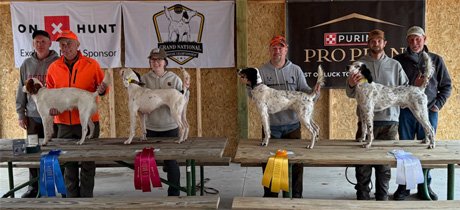
The Grand National Grouse Futurity is a prestigious stake sponsored by the Grand National Grouse Championship. The breeder must nominate both the dam and the litter and then owners follow up with entries and fees. Results of the fall 2024 stake included a third and fourth place finished by littermates Clover Valley’s Evans, second from right, and a fourth place by Big Big Energy, on the right. Both dogs were out of RU-CH Northwoods Atlas x Clover’s Valley Millie.
Northwoods Sunny Day (RU-CH Northwoods Atlas x Northwoods Stardust, 2023), owned and handled by Tom Kieffer, won second place in the Black Moshannon Trial Club Open Derby stake held in Phillipsburg, Pa.
JTH Scion (HOF CH Rock Acre Blackhawk x Northwoods Vixen, 2015), call name Cooper, was bred by us and owned by Jeff Hintz. When Rod Lein bred his female, Over The Hill Patty, he chose Cooper as a sire. Two littermates had big placements this fall.
Over The Hill Morgan, handled by Rod Lein and owned by Robert Zielke, was named champion at the Minnesota Grouse Dog Championship. Bad Habits, owned and handled by Ben Mergens, won runner-up at the Region 19 Amateur Shooting Dog Championship.
Congratulations to all dogs, owners and handlers!
2024: Hail and Farewell
In a nod to the CBS News “Sunday Morning” feature, Betsy and I want to honor two special people and nine dogs that passed away in 2024.
Jeff Hintz (1948 – 2024)
Though our mutual association with grouse trials, Jeff had been a friend since the 1990s. But in 2005, that friendship blossomed to another level when Jeff sold us a chunk of his land where we built our house and kennel. Every summer and fall, Jeff lived next door in his own unique home, Thunder Meadow. We saw him almost every day because he helped us train dogs. He also was one of our biggest supporters and advisors.
Jeff owned lots of dogs—many were pointers he got from us—over the years. He loved his dogs and bird hunting; few dogs worked wild birds more than his. Jeff also competed successfully in field trials for more than four decades. He was especially proud of CH JTH Izzie, a pointer that won off horseback and foot and was the MN/WI Derby of the Year. She pointed many species of upland birds and even retrieved ducks!
Jeff was our neighbor, friend and confidante. We miss him.
Steve Studer (1945 – 2024)
Shortly after I bought my first setter in the late 1980s, I met Steve. He took me to my first big trial, the Grand National Grouse and Woodcock Invitational Classic held in Gladwin, Mich., and we became good friends. We worked dogs together and hunted together. We traveled to Texas every Christmas to hunt and bring dogs for our friend, Roger Buddin, to train. Steve’s Bear Hill pointers were successful competitors in the woods and his pointer male, CH Bear Hill Bob, won the National Amateur Grouse Championship in the early 1990s. Steve was a long-time president of the Minnesota Grouse Dog Assoc.
Steve was also an outstanding chef who was way ahead of his time in cooking ideas. His laugh was loud and infectious and he lifted up everyone around him. Steve was a big man with a big heart. We are grateful and feel fortunate for the years we spent with him.
“Dogs’ lives are too short. Their only fault, really.”
~ Agnes Sligh Turnbull
Two female setters and one male died far too young. Two female pointers and a male setter lived to ages of 13, 14 and 13 respectively. Three setter females from the same litter died this year at age 14. They had spent their entire lives together as their owners all hunted at the same grouse camp.
We will always remember.
Photo Album: Autumn 2024
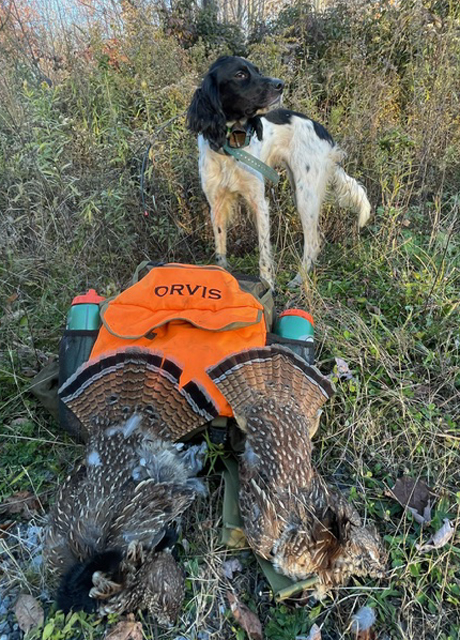
Piper (CH/RU-CH Northwoods Sir Gordon x Houston’s Nelly Bly, 2021) is owned by the Tom McPherson family of Pennsylvania.
Autumn is a hunter’s favorite season of the year. It’s also when Jerry and I hear from happy dog owners around the country. They head out with their dogs as often as they can—sometimes with friends and family and other times by themselves with just one dog. They hunt as long as they can—from early season when foliage is still lush until the snow falls.
Here are photos from some of those hunts. The locations vary from West Virginia and Pennsylvania, to the Lake States, Dakotas and mountains. The birds vary, too, including that most difficult of birds—the ruffed grouse—to woodcock, pheasants, sharp-tailed grouse, chukars, and to perhaps the prettiest of them all, the Hungarian partridge.
What’s especially gratifying is that no matter how old the dogs are and even if their eyebrows are turning gray, they still love to hunt. The ages of dogs in the photos range from six months to 12 years of age.
Many thanks to our dog owners for sharing the photographs. They are arranged in chronological order of the whelp date—from the eldest to the youngest.
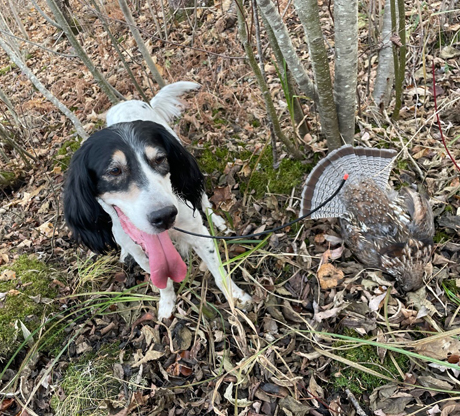
Tana (Northwoods Blue Ox x Northwoods Chablis, 2012) is owned by the Brad Gudenkauf family of Minnesota.

Valencia (Northwoods Grits x Northwoods Carbon, 2017), on left, and Tasha (Blue Shaquille x Snyder’s Liz, 2012) are owned by Tim and Tia Esse of Minnesota.
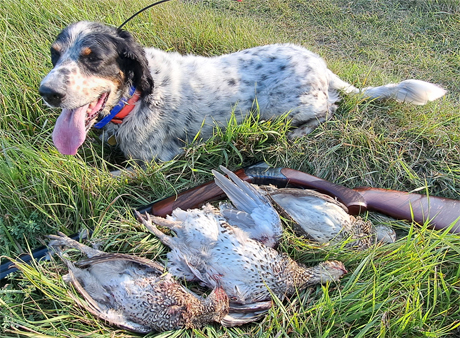
Finn (Northwoods Blue Ox x Northwoods Chablis, 2014) is owned by the Todd Wiedmann family of Minnesota.

Rae (Sunny Hill Sam x Northwoods Carly Simon, 2016) is owned by the Gregg Knapp family of Wisconsin.
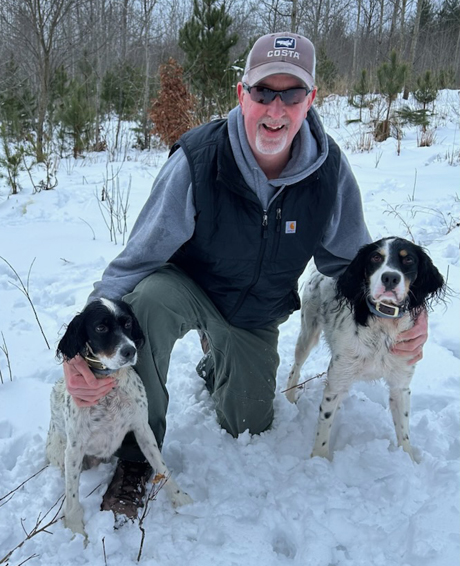
Luna (RU-CH Northwoods Nirvana x Northwoods Carbon, 2017), on left, and Pep (RU-CH Northwoods Atlas x Houston’s Nelly Bly, 2023) are owned by the Mike McCrary family of Michigan.
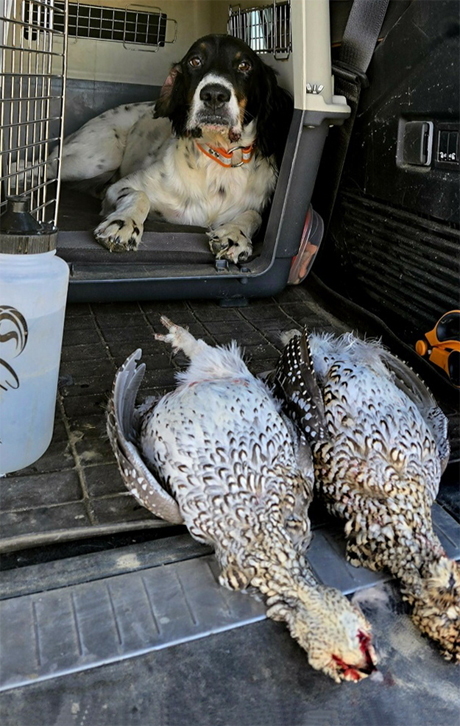
Earl (Northwoods Rolls Royce x Northwoods Valencia, 2020) is owned by Craig and Karen Purse of Wisconsin.
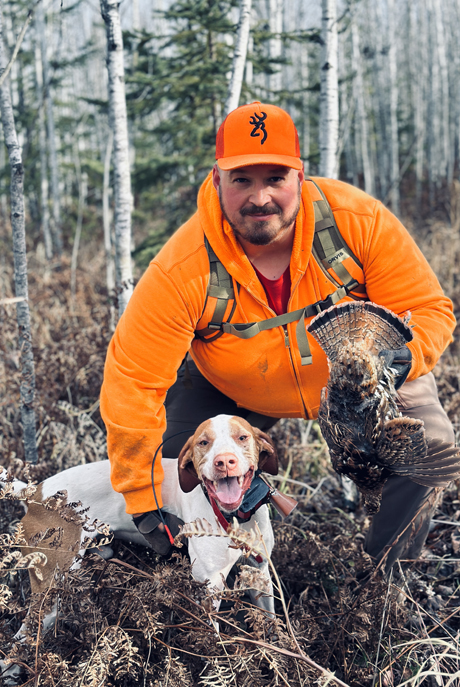
Rickey (HOF CH True Confidence x Northwoods Comet, 2021) is owned by the Jake Beveridge family of Minnesota.
Boone (CH Rufus Del Fuego x Northwoods Valencia, 2021) is owned by the Brady Miele family of Minnesota.
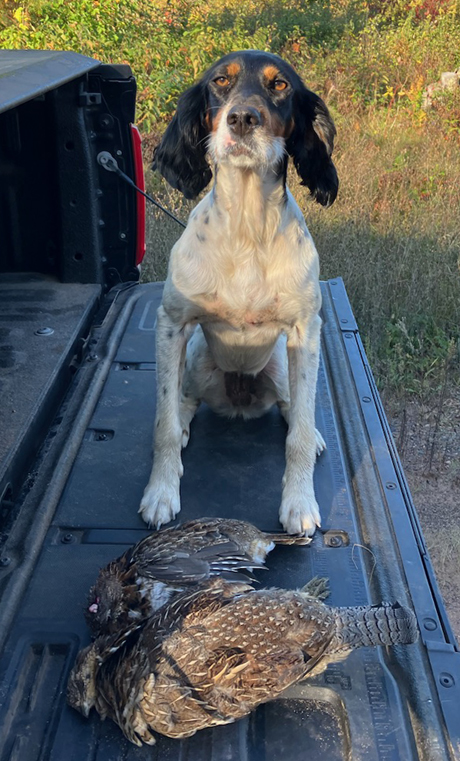
Char (Northwoods Louis Vuitton x Houston’s Dancing Queen, 2022) is owned by Stu McIntosh of Wisconsin.
Legends of Coverdog: Blue Streak
At the banquet preceding the 82nd running of The Grand National Grouse Championship held in early November in the Eau Claire County Forest near Eau Claire, Wis., our 4X CH/4X RU-CH Blue Streak was named this year’s Legends of Coverdog.
Legends of Coverdog is a special award given by The Grand to dogs “that have had a profound impact on the sport of coverdog field trials.” Streak joins only six other bird dogs to earn this award. Jerry and I were shown a commemorative plaque that will be hung in the National Bird Dog Museum in Grand Junction, Tenn.
It was an evening we’ll never forget. We were, at once, honored, thrilled and humbled for Streak to have achieved such distinction.
Blue Streak (Spring Garden Tollway x Finder’s Keeper, 1995) was a setter female Jerry and I bred and owned her entire life. We called her Little because she was the smallest in her litter. But apart from her 36-lb. frame, everything else about her was big—her heart, her drive, her fire and her bird finding.
“She is independent, adaptable and has bottomless guts. What great qualities!”
~Craig Peters, reporter, 2001 Pennsylvania Grouse Championship
Streak’s 22-win career spanned 10 years. She was handled by Jerry and scouted by me. Her first derby placement was in 1996 and, as a 10½-year-old, her final field trial was the 2005 Grand National Grouse Championship where she was named Runner-up Champion.
“Her considerable effort, featuring a pair of good grouse finds added to by a woodcock find, stood up for the runner-up position despite the challenge of 80 other contenders.”
~Dave A. Fletcher and Ryan Frame, reporters, 2005 Grand National Grouse Championship
Streak’s breakout year was 2001. She was entered in six cover dog championships and placed in five: Grand National Grouse and Woodcock Invitational (RU); Pennsylvania Grouse Championship (CH); Minnesota Grouse Championship (RU); Wisconsin Cover Dog Championship (CH); National Amateur Grouse Championship (RU).
Based on that “streak,” Streak won two prestigious awards in 2002: the Michael Seminatore English Setter Award and the William Harnden Foster Award. In addition, she won the Minnesota/Wisconsin Cover Dog Shooting Dog of the Year award in 2002 and 2003.
“Streak finished this brace to the front and hauling the mail. It is seldom that I witness an hour I will never forget, but this will be one that is stamped in my memory. Fantastic!”
~Steve Studer, reporter, 2002 Minnesota Grouse Dog Championship
Although bred only twice, Streak left her mark by producing eight field trial winners including CH Bobby Blue and Blue Silk. Blue Silk won the 2001 Minnesota/Wisconsin Cover Dog Derby of the Year and produced winners CH I’m Blue Gert and CH Satin From Silk.
Of prime significance, Blue Silk’s sons, Blue Shaquille and Northwoods Blue Ox, are foundation sires for our setter breeding program. Through these grandsons, Blue Streak’s legacy continues in 5X CH/5X RU-CH Northwoods Charles, CH/RU-CH Erin’s Three Leaf Shamrock, CH/RU-CH Northwoods Sir Gordon, RU-CH Northwoods Atlas, CH/RU-CH Northwoods Cedar, RU-CH Northwoods Nirvana and RU-CH Cody’s Sadie Bell.
“In her hour, Blue Streak showed us bird savvy, style, race, endurance and excellent manners.”
~Brett Edstrom, reporter, 1999 Region 19 Amateur Shooting Dog Championship
“She had two grouse finds, four woodcock and a back. Combined with a strong, forward easy handling race, it truly was a championship performance.”
~Rod Lein, reporter, 2001 Wisconsin Cover Dog Championship
A personal note from Jerry: Blue Streak challenged me more than any dog before or since. Her tremendous desire to hunt game—whether feathers or fur—along with her endless stamina would sometimes get the best of her. In the days before GPS tracking, this led to her spending a night or two alone in the woods! Streak gave me the highest highs and the lowest lows, but she also taught me important lessons. If you believe in your dog, forge a bond and put in the effort, you can go farther than you ever imagined. In fact, it can change your life.
From Betsy: From the beginning, Little was destined. I remember our first puppy walk with her. Instinctively, right out of the dog topper, Little was off. She charged into the woods, independent but hunting, and she didn’t want to stop. A lifetime of memories also come to mind but my final time with her was especially poignant. More than ten years later when Little had serious lung complications, I stayed up with her all night as she struggled to breathe. Her big heart simply would not quit.

